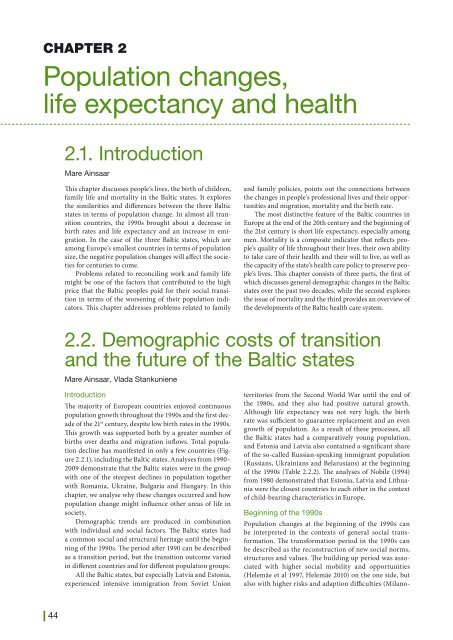2010/2011
Estonian Human Development Report - Eesti Koostöö Kogu
Estonian Human Development Report - Eesti Koostöö Kogu
- No tags were found...
You also want an ePaper? Increase the reach of your titles
YUMPU automatically turns print PDFs into web optimized ePapers that Google loves.
CHAPTER 2<br />
Population changes,<br />
life expectancy and health<br />
2.1. Introduction<br />
Mare Ainsaar<br />
This chapter discusses people’s lives, the birth of children,<br />
family life and mortality in the Baltic states. It explores<br />
the similarities and differences between the three Baltic<br />
states in terms of population change. In almost all transition<br />
countries, the 1990s brought about a decrease in<br />
birth rates and life expectancy and an increase in emigration.<br />
In the case of the three Baltic states, which are<br />
among Europe’s smallest countries in terms of population<br />
size, the negative population changes will affect the societies<br />
for centuries to come.<br />
Problems related to reconciling work and family life<br />
might be one of the factors that contributed to the high<br />
price that the Baltic peoples paid for their social transition<br />
in terms of the worsening of their population indicators.<br />
This chapter addresses problems related to family<br />
and family policies, points out the connections between<br />
the changes in people’s professional lives and their opportunities<br />
and migration, mortality and the birth rate.<br />
The most distinctive feature of the Baltic countries in<br />
Europe at the end of the 20th century and the beginning of<br />
the 21st century is short life expectancy, especially among<br />
men. Mortality is a composite indicator that reflects people’s<br />
quality of life throughout their lives, their own ability<br />
to take care of their health and their will to live, as well as<br />
the capacity of the state’s health care policy to preserve people’s<br />
lives. This chapter consists of three parts, the first of<br />
which discusses general demographic changes in the Baltic<br />
states over the past two decades, while the second explores<br />
the issue of mortality and the third provides an overview of<br />
the developments of the Baltic health care system.<br />
2.2. Demographic costs of transition<br />
and the future of the Baltic states<br />
Mare Ainsaar, Vlada Stankuniene<br />
Introduction<br />
The majority of European countries enjoyed continuous<br />
population growth throughout the 1990s and the first decade<br />
of the 21 st century, despite low birth rates in the 1990s.<br />
This growth was supported both by a greater number of<br />
births over deaths and migration inflows. Total population<br />
decline has manifested in only a few countries (Figure<br />
2.2.1), including the Baltic states. Analyses from 1990–<br />
2009 demonstrate that the Baltic states were in the group<br />
with one of the steepest declines in population together<br />
with Romania, Ukraine, Bulgaria and Hungary. In this<br />
chapter, we analyse why these changes occurred and how<br />
population change might influence other areas of life in<br />
society.<br />
Demographic trends are produced in combination<br />
with individual and social factors. The Baltic states had<br />
a common social and structural heritage until the beginning<br />
of the 1990s. The period after 1990 can be described<br />
as a transition period, but the transition outcome varied<br />
in different countries and for different population groups.<br />
All the Baltic states, but especially Latvia and Estonia,<br />
experienced intensive immigration from Soviet Union<br />
territories from the Second World War until the end of<br />
the 1980s, and they also had positive natural growth.<br />
Although life expectancy was not very high, the birth<br />
rate was sufficient to guarantee replacement and an even<br />
growth of population. As a result of these processes, all<br />
the Baltic states had a comparatively young population,<br />
and Estonia and Latvia also contained a significant share<br />
of the so-called Russian-speaking immigrant population<br />
(Russians, Ukrainians and Belarusians) at the beginning<br />
of the 1990s (Table 2.2.2). The analyses of Nobile (1994)<br />
from 1980 demonstrated that Estonia, Latvia and Lithuania<br />
were the closest countries to each other in the context<br />
of child-bearing characteristics in Europe.<br />
Beginning of the 1990s<br />
Population changes at the beginning of the 1990s can<br />
be interpreted in the contexts of general social transformation.<br />
The transformation period in the 1990s can<br />
be described as the reconstruction of new social norms,<br />
structures and values. The building up period was associated<br />
with higher social mobility and opportunities<br />
(Helemäe et al 1997, Helemäe <strong>2010</strong>) on the one side, but<br />
also with higher risks and adaption difficulties (Milano-<br />
| 44















